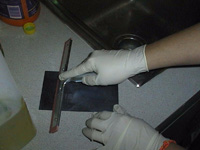Wash Drawing
Intaglio-Type
for Continuos Tone Images
Method for working with painted and drawn imagery.
Materials:
- Drawing Materials (Materials need not be opaque)
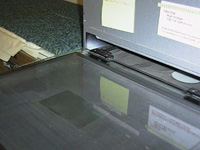
|
This technique is used to create images that have subtle ink/tusche type washes and hand drawn lines. Lines can be created from as many different drawing materials. It is possible to translate approximately 95 of the tonal range to the printed image. The Wash/Drawing technique can be used with or
without the aquatint screen. It is necessary to use the aquatint screen if
open areas of black are present in the art work. If for instance the art
work consists of fine ink or pencil lines the aquatint screen may not be
necessary but if there are continuous tones, the aquatint screen is
critical. Generally it is best to err on the side of using the aquatint
screen when in doubt. |
Image Making Techniques
|
|
| Olec Exposure Unit |
Multi-colored Plates:Water-soluble pencils and acrylics are especially suited for multicolored plates where each different colored wash drawing, made onto drafting Mylar, can be overlaid on the previous drawing before making the plates.
|
|
|
ExposureIn this technique the ImagOn coated plate is exposed two or three times in succession.
Constant Exposure which has been calibrated. The aquatint screen simulates the results of conventional etching aquatints by exposing a densely clustered random dot onto the ImagOn coated plate. . Constant Exposure (with some exceptions) calibrated to each exposure unit. |
|
Rubber gloves RECOMMENDED for the development procedure. Repeated use of developing solution can dry out the skin and cause a dermatitis reaction on the hands. Eye protection advised. The developer is an alkaline solution. Do not splash the developing solution into eyes.
|
Develop
|
Dry Plate
|
|
After the plate has etched it can be printed with the ImagOn emulsion still intact on the plate. This makes the plate easier to wipe and may preserve some minute details that did not etch. It is advisable to proof the plate first with the ImagOn emulsion on the plate and then with this emulsion removed. Comparing both results will enable you to determine exactly which areas of the plate did actually etch. The ImagOn emulsion is removed in the same manner described under the Basic ImagOn Process Handout. It should also be noted that further image manipulation can occur if the ImagOn emulsion is selectively removed from the plate. Sanding with 600-grit sandpaper can most easily control this. Where the ImagOn emulsion is retained on the plate there will be no plate tone and where the ImagOn is removed there will be plate tone. Clean Up of Printing Plate and Inking Station
Keep studio orderly. |

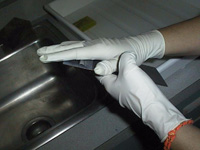
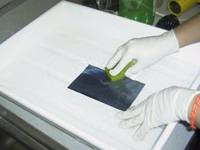
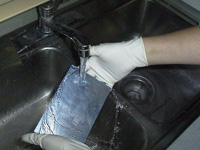 .
. 